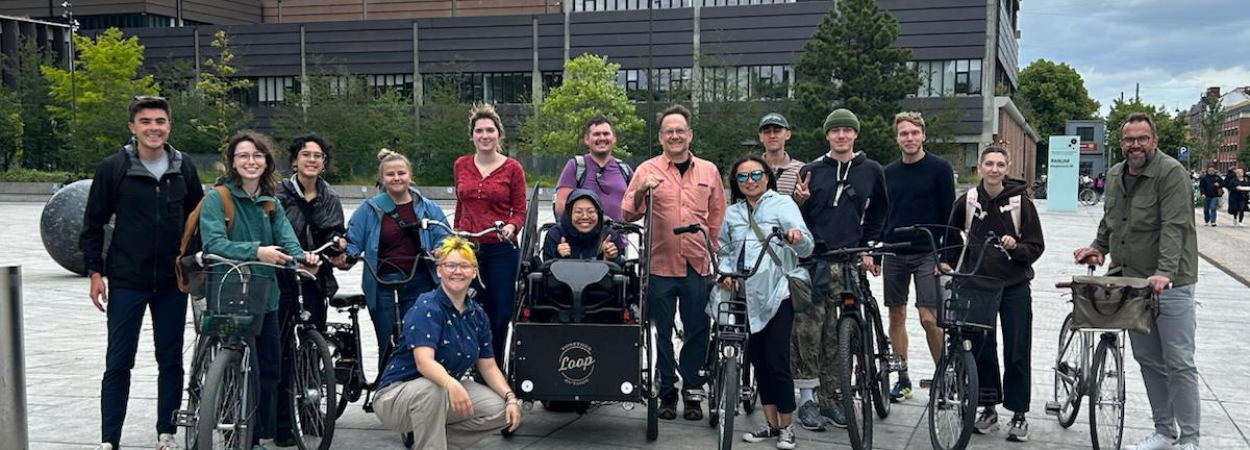The 2025 Portland State University (PSU) Sustainable Transportation Study Abroad class has returned from Denmark, after an immersive exploration of what it takes to build a city for people rather than cars. Through daily bike and transit tours, lectures, and firsthand observations, students learned that making transportation safe and convenient isn’t about one magic policy; it’s a system of integrated decisions—like Copenhagen’s Finger Plan, its cycle superhighways, and a deeply ingrained culture of biking—that together create a vibrant, livable city.
With support from ScanDesign Foundation, the Sustainable Transportation Study Abroad program aims to introduce students to multimodal transportation and land use applications in an international context. This year's cohort of twelve students, along with instructors John MacArthur and Hau Hagedorn, met with officials from transportation organizations like the Danish Road Directorate and consultancy firms Raw Mobility and Niels Hoe 360 Consulting. Students drew comparisons between Copenhagen and U.S. cities, experiencing firsthand what it was like to get around by walking, bikes and transit in Copenhagen. Along the way, they faced challenges—navigating foreign infrastructure, accessibility issues, even personal injuries—and discovered that livable cities require more than good design: they demand empathy and inclusion.
Accessibility in a Cycling City
Phoebe Park is pursuing a masters of science in urban and regional planning from Temple University. She is pursuing a Master's degree to better understand how to advocate for the disabled community in transportation planning. As an ambulatory wheelchair user, Park made firsthand observations of the accessibility of the infrastructure around Copenhagen which provided valuable insights into the challenges faced by wheelchair users in a city celebrated for its bike-friendly design.
"The first day in Copenhagen, I noticed that there weren't always sidewalk curb cuts, and where there were curb cuts, they were not easy to use," Park said.
She also noted several accessibility barriers throughout the transit system, including broken elevators, non-functional powered bus ramps, and frequent inconsistent heights between boarding platforms and vehicle floors. However, the city remains in motion, as residents work around the gaps in access.
"There are many other mobility aids used on the sidewalks, whether it be a smooth pavement or a cobblestone lined street. From strollers to walkers, the disabled people and young children are out and about!" Park said.
Learning from Copenhagen—and Bringing Ideas Home
Beyond experiencing the infrastructure firsthand, students completed assignments that encouraged critical comparisons between Copenhagen and U.S. cities. One assignment was to compare the Copenhagen Bicycling Strategy with a city bike plan for anywhere in the United States. Aiden Moreno, a fourth-year urban studies and planning student at PSU, compared Copenhagen's bike plan with Seattle's and found key differences.
“Seattle’s plan reads like a legal document, whereas Copenhagen’s is short, clear, and focused on achievable goals,” Moreno said. “Both plans address more than infrastructure, including culture and comfort. But Copenhagen’s vision-driven approach is easier for the public to understand and support.”
While comparing plans revealed clear differences in approach, experiencing transportation systems firsthand added another layer of understanding for Moreno. Seeing how policies played out in real life reinforced the idea that context matters as much as design.
"Each city that we visited had a different culture, different political outlook, and each ended up with different infrastructure. Even in cities with the same infrastructure, the way residents interacted with it and how the city managed it differed based on local preferences. What this meant to me in terms of application is that while planners should still push best practices and standards improvement, the local community should inform the design and planning of infrastructure the most. I think this idea in particular could be very beneficial in Seattle," Moreno said.
Other lessons went beyond cycling. Students explored how Copenhagen’s Finger Plan curbs sprawl by concentrating development along five railway lines. “The Finger Plan has resulted in cities surrounding Copenhagen having their own distinct character and uncongested skylines, without being so spread out that anyone has to walk more than 15 minutes to the train station,” said Grace Alston, a PSU master’s student and intern at the Portland Bureau of Transportation. “Denmark has found the harmonious space between urban development and environmental preservation.”
For Future Churchill, a fourth-year planning student and Portland Aerial Tram operator, Copenhagen’s cycling infrastructure left a strong impression. His top takeaways: raised bike lanes, wide spaces for passing, and cycle superhighways that stretch for miles.
"I rode ten miles along a superhighway south of Copenhagen to visit the southern shore. They are designed to have as few interruptions as possible, which is the primary reason I find them particularly comfortable. Reducing the number of intersections also increases safety, given that many bicycle accidents take place at intersections. My trip was basically uninterrupted for nearly six miles!" Churchill said.
The trip highlighted key takeaways that apply back home: prioritize protected bike lanes, design intersections for safety, engage communities in planning, and connect transportation to housing and climate strategies. Most importantly, students returned with a sense of possibility: U.S. cities may have a long way to go, but the building blocks for vibrant, human-scale communities already exist—they just need champions to bring them together.
Learn more about the Sustainable Transportation Study Abroad program, see more photos from this year, or sign up to be notified when applications open for 2026.




